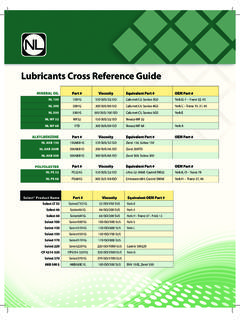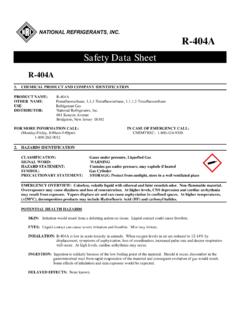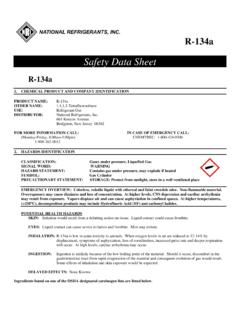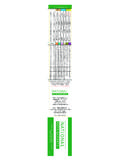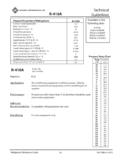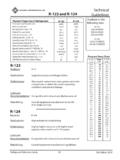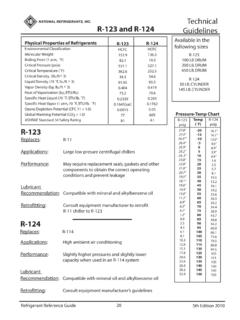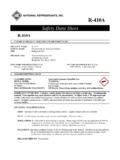Transcription of Safety Data Sheet - Refrigerants
1 R-290. Safety data Sheet R290 PROPANE. 1. CHEMICAL PRODUCT AND COMPANY IDENTIFICATION. PRODUCT NAME: PROPANE. OTHER NAME: Liquefied Petroleum Gas (LPG). USE: Refrigerant Gas DISTRIBUTOR: National Refrigerants , Inc. 661 Kenyon Avenue Bridgeton, New Jersey 08302. FOR MORE INFORMATION CALL: IN CASE OF EMERGENCY CALL: (Monday-Friday, 8:00am-5:00pm) CHEMTREC: 1-800-424-9300. 1-800-262-0012. 2. HAZARDS IDENTIFICATION. CLASSIFICATION: Flammable Gas, Gas under pressure, Compressed Gas SIGNAL WORD: DANGER. HAZARD STATEMENT(S): Extremely flammable gas, Contains gas under pressure, may explode if heated SYMBOL(S): Flames, Gas Cylinder PRECAUTIONARY STATEMENT(S): Prevention: Keep away from heat, sparks, open flame, and hot surfaces.
2 No Smoking Response: Leaking gas fire: Do not extinguish unless leak can be stopped immediately. Eliminate all ignition sources if safe to do so. Storage: Protect from sunlight, store in a well ventilated place. EMERGENCY OVERVIEW: Flammable gas. Liquid under high pressure. POTENTIAL HEALTH EFFECTS: Effects of Overexposure: Eye Contact No known significant effects or critical hazards. Skin Contact No known significant effects or critical hazards. _____. MSDS: PROPANE Page 1 of 6. Current Issue Date: Aptil 2015. R-290. Inhalation Acts as simple asphyxiant.
3 Ingestion Ingestion is not a normal route of exposure for gases 3. COMPOSITION / INFORMATION ON INGREDIENTS. INGREDIENT NAME CAS NUMBER WEIGHT %. Propane 74-98-6 100. COMMON NAMES and SYNONYMS. Liquefied Petroleum Gas (LPG) R-290. There are no impurities or stabilizers that contribute to the classification of the material identified in Section 2. 4. FIRST AID MEASURES. SKIN: In case of contact, immediately flush skin with plenty of water. Remove contaminated clothing and shoes. Wash clothing before reuse. Thoroughly clean shoes before reuse. Get medical attention.
4 EYES: Immediately flush eyes with plenty of warm water for at least 15 minutes. Get medical attention. INHALATION: Immediately remove to fresh air. If breathing has stopped, give artificial respiration. If breathing is difficult, qualified personnel may give oxygen. Get medical attention immediately. INGESTION: Do NOT induce vomiting unless directed to do so by medical personnel. Never give anything by mouth to an unconscious person. Get medical attention if symptoms appear. ADVICE TO PHYSICIAN: No specific treatment. Contact poison treatment specialist immediately if large amounts have been inhaled or ingested.
5 5. FIRE FIGHTING MEASURES. FLAMMABLE PROPERTIES. FLASH POINT: AUTO IGNITION TEMPERATURE: F ( C). UPPER EXLOSIVE LIMIT (volume % in air): LOWER EXPLOSIVE LIMIT (volume % in air): EXTINGUISHING MEDIA: These products are carbon oxides (CO,CO2). UNUSUAL FIRE HAZARDS: Extremely flammable in presence of open flames, sparks and static discharge of oxidizing materials. _____. MSDS: PROPANE Page 2 of 6. Current Issue Date: Aptil 2015. R-290. FIRE FIGHTING INSTRUCTIONS: CO2, dry chemicals, water spray, or fog. If involved in fire, shut off flow immediately if it can be done without risk.
6 Apply water from a safe distance to cool container and protect surrounding area. Extremely flammable. Gas may accumulate in confined areas, travel considerable distance to source of ignition and flash back causing fire or explosion. Fire fighters should wear appropriate protective equipment and self-contained breathing apparatus (SCBA) with a full face piece operated in positive pressure mode. 6. ACCIDENTAL RELEASE MEASURES. SPILL AND LEAK PPROCEDURES: Immediately contact emergency personnel. Keep unnecessary personnel away. Use suitable protective equipment (Section 8).
7 Shut off gas supply if this can be done safely. Isolate area until gas has dispersed. Avoid dispersal of spilled material and runoff and contact with soil, waterways, drains and sewers. 7. HANDLING AND STORAGE. NORMAL HANDLING: Keep container closed. Use only with adequate ventilation. Keep away from heat, sparks and flame. To avoid fire, minimize ignition sources. Use explosion-proof electrical (ventilating, lighting and material handling) equipment. Do not puncture or incinerate container. High pressure gas. Use equipment rated for cylinder pressure. Close valve after each use and when empty.
8 Protect cylinders from physical damage; do not drag, roll, slide, or drop. Use a suitable hand truck for cylinder movement. STORAGE RECOMMENDATIONS: Keep container tightly closed. Keep container in a cool, well-ventilated area. Cylinders should be stored upright, with valve protection cap in place, and firmly secured to prevent falling or being knocked over. Cylinder temperatures should not exceed 52 C (125 F). 8. EXPOSURE CONTROLS / PERSONAL PROTECTION. ENGINEERING CONTROLS: Use only with adequate ventilation. Use process enclosures, local exhaust ventilation, or other engineering controls to keep airborne levels below recommended exposure limits.
9 The engineering controls also need to keep gas, vapor or dust concentrations below any explosive limits. Use explosion-proof ventilation equipment PERSONAL PROTECTION: SKIN PROTECTION: Personal protective equipment for the body should be selected based on the task being performed and the risks involved and should be approved by a specialist before handling this product. EYE PROTECTION: Safety eyewear complying with an approved standard should be used when a risk assessment indicates this is necessary to avoid exposure to liquid splashes, mists or dusts. RESPIRATORY PROTECTION: Use a properly fitted, air-purifying or air-fed respirator complying with an approved standard if a risk assessment indicates this is necessary.
10 Respirator selection must be based on known or anticipated exposure levels, the hazards of the product and the safe working limits of the selected respirator. _____. MSDS: PROPANE Page 3 of 6. Current Issue Date: Aptil 2015. R-290. The applicable standards are (US) 29 CFR and (Canada) EXPOSURE GUIDELINES. (Exposure Limits). INGREDIENT NAME ACGIH TLV OSHA PEL OTHER LIMIT. Propane 1000 ppm 1000 ppm 9. PHYSICAL AND CHEMICAL PROPERTIES. APPEARANCE: Colorless, liquefied compressed gas PHYSICAL STATE: Gas at ambient temperature ODOR: Odorless SOLUBILITY IN WATER: g/liter BOILING POINT: F ( C).
